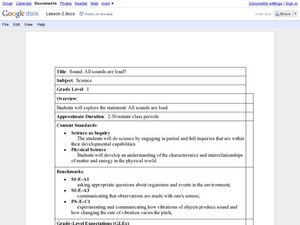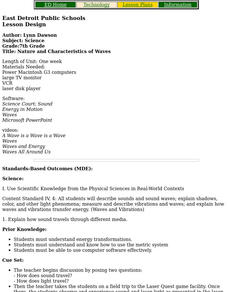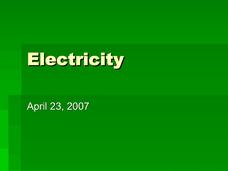Curated OER
Sound: Are All Sounds Loud?
First graders explore physics by utilizing education software. In this sound properties lesson, 1st graders discuss the different sounds associated with different materials and perform an object dropping experiment in class. Students...
Curated OER
Characteristics of Energy
Students explore Earth science by completing energy worksheets in class. In this energy forms lesson, students identify and define a list of energy vocabulary terms and a K-W-L chart. Students view a matter video clip in class and...
Curated OER
Making Waves, Making Music, Making Noise
Students construct "talking cans" and instruments to explain how vibration of objects produces various sounds.
Curated OER
From Bats to Babies: Ultrasound
Students research and analyze sound waves and how an ultrasound works to image a baby in utero. They explore various websites, complete worksheets, and write a paragraph describing a demonstration they view in the classroom.
K12 Reader
Waves and Currents
Waves, currents, crests, and troughs. Using information provided in an article about waves and currents, readers define terms used to describe how energy travels.
DiscoverE
Slinky® Science
Toys are great for learning about physics. Scholars use Slinky® toys to study Newton's laws of motion and types of energy. After a little play, they then model longitudinal and transverse waves with the Slinky® toys.
Curated OER
Observing Sound
Second graders study the five senses and the link between pictures and sound. In this sound lesson students discover that sound is vibration, it is described by volume and pitch.
Curated OER
Good Vibrations
Students demonstrate sound waves and make changes in the waves
resulting in changes in pitch. Students associate changes in pitch in various "musical instruments"with size and shape and the sound waves they produce.
Curated OER
Sounds Like Science - Kazoo
Students discover that energy is needed to produce sound. They see that identifying where the energy comes from enables us to control the type of sound produced. They play the kazoo and manipulate the sound in a variety of ways.
Curated OER
Energy Source
Sixth graders work in groups. They are given one type of energy to research. Students look through the different magazines or newspapers to identify pictures that show their type of energy. Students glue their pictures to the...
Curated OER
TE Activity: Pitch and Frequency
Students experiment with a vibrating ruler and a kazoo to study the different pitches and frequencies they produce. They create both high and low pitch sound waves. They examine how engineers use sound energy when designing electronic...
Curated OER
Radio Waves
In this radio waves worksheet, students read about how broadcasting uses radio waves to deliver sound and how radio signals are received. Then students complete 3 short answer questions.
Curated OER
Sizing Up Sound
Sixth graders are introduced to the concepts of sound waves and frequency. As a class, they listen to the differences between different types of instruments. To end the lesson, they practice identifying low and high pitches and playing...
Dr. Seuss Enterprises
Read Across America
Celebrate the whimsical world of Dr. Seuss on Read Across America Day with a collection of science, technology, engineering, the arts, and mathematics activities, each linked to a popular Dr. Seuss story.
Curated OER
Nature and Characteristics of Waves
Seventh graders research different types of waves, identify the parts of a wave and create a Power Point presentation demonstrating what they have learned.
Curated OER
Let the Sunshine in
Students collect and analyze data to study wavelengths of visible light. They cover Styrofoam cups with three different colors of sun filtering products and shine a lamp directly on the cups. They determine the most effective filtering...
Columbus City Schools
Making Waves
Learning about waves can have its ups and downs, but a demo-packed tool kit has the class "standing" for more! Learners gain experience with several different wave types, organizing observations and data, and wave terminology. The...
Curated OER
Making Waves, Making Music, Making Noise
Sixth graders watch a demonstration on how talking cans produce sounds. In groups, they compare and contrast the sounds from different sized cans. They participate in a variety of activities to discover how sounds are made and how...
Curated OER
Designing Musical Instruments
Young scholars examine musical instruments as main part of the study of sound energy. In this designing instruments lesson plan, students focus on the elements of an instrument that cause sound to be created and design a unique musical...
Curated OER
Sources of Electricity
In this online electricity worksheet, students are asked 10 questions about electric current and battery energy, an online answer key provided.
Curated OER
Light the Bulb
Students explore electricity. In this power experiment lesson, students determine what is required for lighting a bulb. Students develop an understanding of open and closed circuits, and how energy is formed
Curated OER
Tune Up Your Ears!
Students discuss meaning of pitch, listen for different sounds in classroom, hallway, and outdoors, and listen to sounds played on piano and on computer to determine high or low pitch.
Curated OER
A Black Box Problem: How Do I Hear?
Young scholars assemble a diagram of the hearing pathway using information about its parts and their function, and predict the changes in hearing that might result from specific changes to the pathway.
Curated OER
Electricity
The presentation begins with a circuit building activity and two data tables for young scientists to copy and complete. Full of clever animations, it will definitely spark student interest! However, the information is incoherent. You may...

























